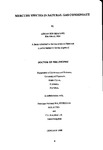Mercury species in natural gas condensate
| dc.contributor.author | Shafawi, Azman Bin | |
| dc.contributor.other | School of Geography, Earth and Environmental Sciences | en_US |
| dc.date.accessioned | 2013-09-13T10:51:48Z | |
| dc.date.available | 2013-09-13T10:51:48Z | |
| dc.date.issued | 1999 | |
| dc.identifier | NOT AVAILABLE | en_US |
| dc.identifier.uri | http://hdl.handle.net/10026.1/1693 | |
| dc.description | Merged with duplicate record 10026.1/705 on 14.03.2017 by CS (TIS) | |
| dc.description.abstract |
The presence of ultra-trace levels of mercury in industrial gas and condensate streams is a cause of both environmental and production concern. The toxic nature of the element, in all forms, together with its ability to shut-down large processing plants dictates a need for its accurate and precise measurement. The study which investigated the recovery of various mercury species, spiked into synthetic and real condensate samples using conventional and new digestion and/or extraction techniques showed recovery was dependent upon the speciation. Using the most efficient technique, L<cysteine with persulphate, recoveries of over 90 % were obtained for diphenyl mercury, ethyl and phenyl mercury chlorides and mercury chloride. The recovery of 15% for the important dimethyl mercury species limits the use of this technique. A novel technique has been developed for the determination of total mercury in complex liquid hydrocarbons. Samples (up to 1.0 ml) were vaporised (400oC) and swept through a gold-coated silica trap maintained at 200°C, which retained all mercury species and discarded the matrix. The trap when heated to 900°C released the mercury for measurement by atomic fluorescence spectrometry (AFS). The recoveries for eight mercury species spiked (10 to 50 ng ml into toluene and condensate were generally over 90 %. The instrumental limit of detection (LOD) was 11 pg. The total mercury content of gas condensates, gasolines and heavy oils were determined. Gas chromatograhy coupled, via a pyrolysis interface, with AF detection was able to determine mercury species in gas condensate, at picogram levels (LOD: 2.5 to 7 pg) using a direct sample injection procedure. For a given column system the positive identification and quantification of up to eight mercury species was obtained. A maximum injector temperature of 125oC was recommended, to avoid the conversion of species. Mass balance calculations show a strong correlation between the total mercury content and the sum of the lower dialkyl mercury species, for all condensate samples studied. Three commercially available mercury removal systems, A, B and C produced a reduction in the mercury content of hydrocarbon streams under pilot plant conditions. The two stage system, 'A', produced a minimum of 30 % conversion from organomercury to elemental mercury after the hydrogenation reaction in stage 1. While elemental mercury was adsorbed by the stage 2 reactor, the organomercury species were not removed. The single stage adsorber 'B' showed 100 % removal efficiency for three dialkyl mercury species in liquid hydrocarbon streams. The removal efficiency for adsorber 'C was species dependent. Two common condensate species gave values of 50 to 80 % removal efficiency while the third species showed time-dependent bleed-off. | en_US |
| dc.description.sponsorship | Petroliam Nasional Bhd, PETRONAS MALAYSIA, and P.S. Analytical Ltd. United Kingdom | en_US |
| dc.language.iso | en | en_US |
| dc.publisher | University of Plymouth | en_US |
| dc.title | Mercury species in natural gas condensate | en_US |
| dc.type | Thesis | |
| plymouth.version | Full version | en_US |
| dc.identifier.doi | http://dx.doi.org/10.24382/4457 | |
| dc.identifier.doi | http://dx.doi.org/10.24382/4457 |
Files in this item
This item appears in the following Collection(s)
-
01 Research Theses Main Collection
Research Theses Main


